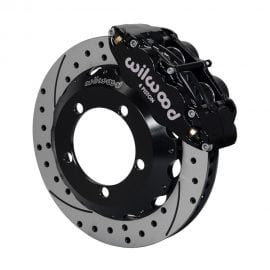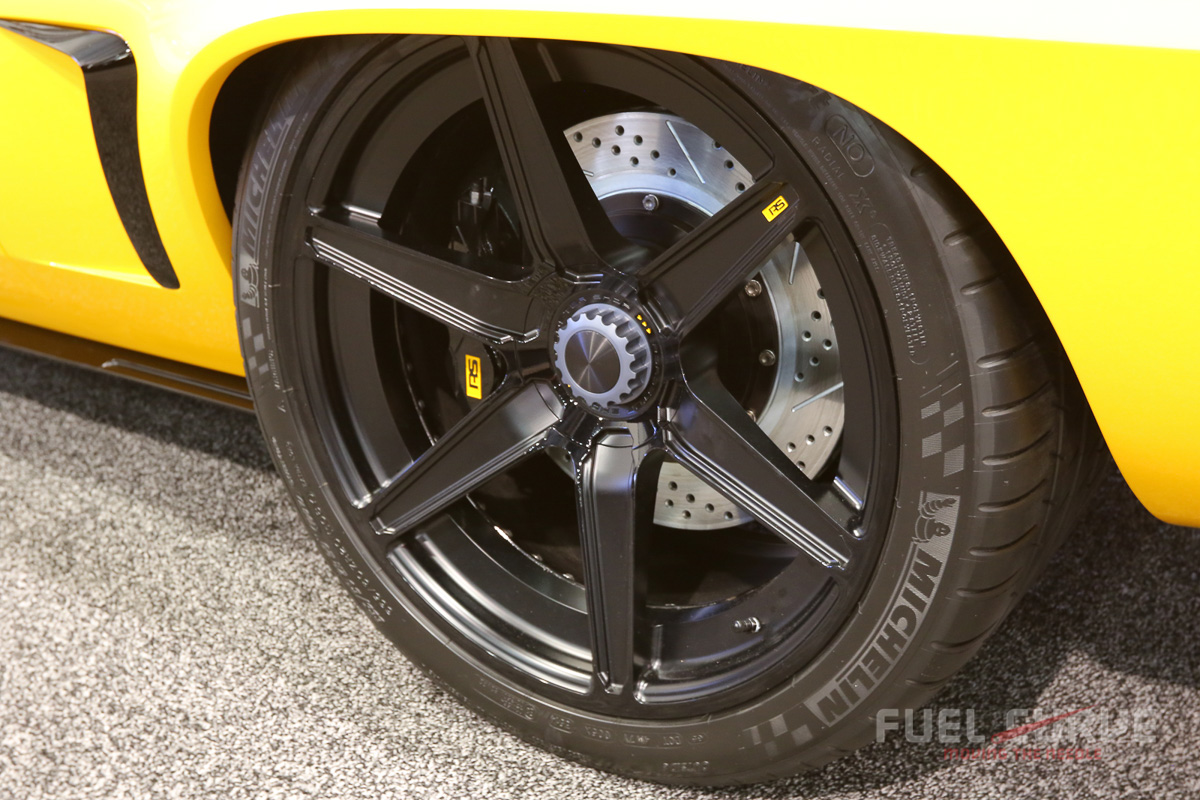Are Drilled/Slotted Brake Rotors Better or Worse than Plain Rotors?
We’re seeing many hot rods with great looking drilled and/or slotted brake rotors behind big billet as well as forged wheels. There’s no question that they look trick, but what is the straight story on how they work? Are they better than plain rotors, or worse? In the real world of street driven cars, will they help my stopping power? Rather than listen to a lot of opinions, let’s look at the science behind these questions by getting info from the experts at Wilwood brakes and ECI.
 Mike Skelly of Wilwood offered us a little history on the origin of drilled rotors. As road racing tires allowed greater track speeds in the 1960s, race teams began seeing a great loss in brake capability. In that era of organic and asbestos based pad friction material, a problem occurred with the adhesives used to fasten the pad to the steel backing plates. As the temperature of the pads increased, the adhesive would break down and cause a layer of gas to form between the rotor and the pads. That vapor layer retained heat in the rotor and acted as an “air-bearing” high-pressure area between the pad and brake rotors. By drilling holes in the rotor brakes surface, those gasses were able to be dissipated into the vented center of the rotor, no longer interfering with the pad-to-rotor friction. Racers also liked the idea that the rotating mass of the rotor was reduced, causing a small advantage of less inertia during acceleration and braking.
Mike Skelly of Wilwood offered us a little history on the origin of drilled rotors. As road racing tires allowed greater track speeds in the 1960s, race teams began seeing a great loss in brake capability. In that era of organic and asbestos based pad friction material, a problem occurred with the adhesives used to fasten the pad to the steel backing plates. As the temperature of the pads increased, the adhesive would break down and cause a layer of gas to form between the rotor and the pads. That vapor layer retained heat in the rotor and acted as an “air-bearing” high-pressure area between the pad and brake rotors. By drilling holes in the rotor brakes surface, those gasses were able to be dissipated into the vented center of the rotor, no longer interfering with the pad-to-rotor friction. Racers also liked the idea that the rotating mass of the rotor was reduced, causing a small advantage of less inertia during acceleration and braking.
Slotting the rotor is felt to have its greatest effect removing worn off pad debris from the rotor surface. The relatively sharp edges of the slots are also considered as an aid in resolving the pad glazing that can occur at high temperatures. Fresh pad material is then exposed for better braking action at the cost of faster pad wear due to the constant renewing of the pad surface. The conclusion is that slotting may improve braking, with little chance of loss.
Since asbestos based brake pads were outlawed in the nineties, new materials and bonding adhesives have been developed. The now common ceramic based pads do not produce the outgassing problem in any conceivable street use, so there is no real function based reason to use drilled rotors. Slotted rotors may still be useful in their ability to remove pad glazing but consequently produce faster pad wear. That spells more brake dust on your wheels. That dust can be corrosive to aluminum wheels, as are many of the chemical cleaners used to remove that dust. Since most hot rods are not driven hard enough to get hot enough to glaze the pads, slotted rotors may offer little in the way of better brake function.
It’s important to recall that a major function of the rotor is to transfer heat out of the brake system. The laws of Physics tell us that energy can be moved and converted to other forms of energy but never destroyed. That means the kinetic energy (i.e. rotating mass) of the rolling wheel and tire are resisted by the brakes, which convert that motion energy into heat energy. That heat is then dissipated into the air by the cooling of the caliper body and rotor. Think of the rotor as the radiator for the brake system. That’s why brake fluids with higher temperature tolerances were developed — and why vented brake rotors are common today.
Following that heat transfer logic tells us that a rotor with more mass can absorb more heat energy than a lighter rotor of the same design. That is an advantage of larger diameter rotors, along with the greater leverage of increased size. The problem with regard to our question of drilled and slotted rotors is that those practices act to reduce the mass of the rotor, reducing the desired heat transfer. Some rodders have correctly stated that the brake rotors surface area is increased by drilling or slotting, but the issue in heat transfer is mass, not surface area. It does seem that a greater rotor surface area may allow a faster cool down after the heavy braking has stopped, but the issue is more about heat transfer during braking due to rotor total mass.
It is the experience based opinion of every single brake expert I have consulted that the loss of rotor mass due to drilling and slotting creates more brake loss than any possible gains due to degassing or faster cooling of the surface area. There is no better authority on hot rod brakes than Ralph Lisena at ECI. Ralph agrees that practical street driven vehicles rarely encounter the high heat conditions that make drilled or slotted rotors beneficial from a strictly functional standpoint.
 For the street, you want a heavier, larger diameter rotor. As a case in point, the ’73-’87 Chevy pickups offered a light duty one-inch thick front rotor, and a heavy duty option that was one and a quarter-inch thick. Since both were twelve-inch diameter cast iron vented rotors, using calipers of the same piston bore and using the same pads, the conclusion we draw is that GM engineers agreed that the larger rotor mass would produce the desired better brakes for heavier loads.
For the street, you want a heavier, larger diameter rotor. As a case in point, the ’73-’87 Chevy pickups offered a light duty one-inch thick front rotor, and a heavy duty option that was one and a quarter-inch thick. Since both were twelve-inch diameter cast iron vented rotors, using calipers of the same piston bore and using the same pads, the conclusion we draw is that GM engineers agreed that the larger rotor mass would produce the desired better brakes for heavier loads.
So we seem to be back to the idea that the major issue in brake system heat transfer is the rotor mass. Outgassing of heated brake pads is not an issue in any conceivable street application. Therefore, drilling the brake rotors may cause a very small loss of braking power, rather than an increase. But we may be over thinking a small issue. The consensus among experts is that there will be little effect either way in the real world. So if you like the way they look, go for it. You’ll have the racy look and the car should stop just fine.






